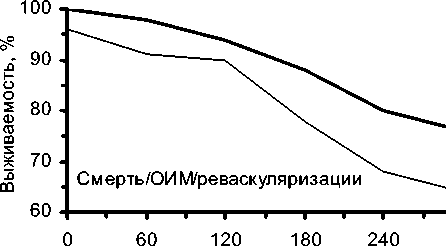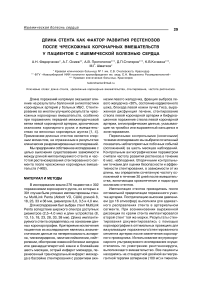Длина стента как фактор развития рестенозов после чрескожных коронарных вмешательств у пациентов с ишемической болезнью сердца
Автор: Федорченко А.Н., Осиев А.Г., Протопопов А.В., Столяров Д.П., Кочкина К.В., Шматков М.Г.
Журнал: Патология кровообращения и кардиохирургия @journal-meshalkin
Рубрика: Ишемическая болезнь сердца
Статья в выпуске: 3 т.12, 2008 года.
Бесплатный доступ
276 patients with 302 lesions of coronary bloodstream, with MultiLink Penta stents (Abbott VD, USA) implanted successfully in 301 cases, were included in this multipurpose study aimed at determining the relation between the length of the implanted stent and the frequency of restenoses after percutaneous coronary intervention. Immediate results of the interventions proved to be better in patients with shorter stents, with residual stenosis equal to 16 % as compared to 20 % in the groups with 33 mm and 38 mm stents. In the course of observation, the groups with shorter stents also demonstrated better parameters: the degree of stenosis, minimal diameter of artery lumen, occurrence of restenoses, delayed loss of artery lumen and concurrent frequency of unanticipated adverse events (complications), particularly the occurrence of repeated revascularizations (23.8 % and 33.7 %, р = 0,048). Thus, treating coro-nary arteries with long stents is accompanied by an increase in the occurrence of side effects and is the subject of further search for new technologies.
Длина стента, чрескожные коронарные вмешательства, стентирование, частота рестенозов
Короткий адрес: https://sciup.org/142233198
IDR: 142233198
Текст научной статьи Длина стента как фактор развития рестенозов после чрескожных коронарных вмешательств у пациентов с ишемической болезнью сердца
Длина поражений напрямую оказывает влияние на результаты баллонной ангиопластики коронарных артерий у больных ИБС. Стентирование во многом улучшило результаты чрескожных коронарных вмешательств, особенно при поражениях передней межжелудочковой ветви левой коронарной артерии, хронических окклюзиях коронарного русла и вмешательствах на венозных коронарных шунтах [1, 4]. Применение длинных стентов является спорным моментом, не отраженным в результатах клинических рандомизированных исследований.
Мы предприняли собственное исследование с целью выяснения существования зависимости между длиной имплантируемого стента и частотой рестенозирования стентированного сегмента после чрескожных коронарных вмешательств (ЧКВ).
МАТЕРИАЛ И МЕТОДЫ
В исследование вошли 276 пациентов с 302 поражениями коронарного русла, из которых в 301 случае были успешно имплантированы стенты MultiLink Penta (Abbott VD, США) длиной 8, 18, 23, 33 и 38 мм, диаметром 3,0, 3,5 и 4,0 мм.
Первичными контрольными (конечными) точками исследования мы выбрали сочетанный показатель неблагоприятных побочных событий (осложнений) за шесть месяцев наблюдений. Контрольным ангиографическим параметром считали частоту развития рестеноза в течение 6 мес. наблюдения. Вторичными контрольными точками для оценки безопасности и эффективности стентирования, в зависимости от их длины, мы определили сочетанную частоту осложнений в течение 30 дней после вмешательства, включающих кровотечения и подострую окклюзию стентов.
Имплантация стентов проводилась после оптимальной предилатации пораженного участка артерии. Постдилатацию высоким давлением (до 16 атмосфер) выполняли для адекватного расправления стента в артериальном сегменте. При возникновении выраженной диссекции по краям стента имплантировался второй стент той же марки. Результаты стентирования документировались с помощью коронарографии в оптимальных проекциях для визуализации пораженного/стентированного сегмента артерии после извлечения коронарного проводника. Использование внутрикоро-нарного ультразвукового исследования осуществлялось по усмотрению рентгенохирурга, выполняющего вмешательство. Все пациенты находились на стандартной двойной антиагрегантной терапии аспирином (100 мг) и тиенопи- ридинами в терапевтической дозе за пять дней до вмешательства и, как минимум, в течение 4 недель после стентирования. Во время вмешательства использовали болюс гепарина 10 000 ЕД с увеличением дозы до 15000 ЕД по окончанию стентирования. Блокаторы GP IIb/ IIIa рецепторов тромбоцитов не применялись. Антиишемические препараты назначались в соответствии с рекомендациями кардиологов.
Для статистической обработки полученных результатов применяли традиционные методики: тест chi-square, логистический и линейный регрессивный многофакторный анализ.
РЕЗУЛЬТАТЫ
Клиническая характеристика пациентов отражена в табл. 1. Распределение стентов по длине сложилось следующим образом: 8 мм -33 стента; 18 мм - 62 стента; 23 мм - 72 стента; 33 мм - 52 стента и 38 мм - 45 стентов. В 38 случаях (12,6%) пришлось имплантировать дополнительные стенты. Оптимальные ангиографические результаты стентирования удалось достичь в 98,6% случаев.
Осложнения госпитального периода зафиксированы у 7 больных: два пациента перенесли трансмуральный инфаркт миокарда (0,7%), у трех больных развился мелкоочаговый инфаркт (1%), в двух случаях (0,7%) мы прибегли к повторным вмешательствам. Развитие диссекций документировано нами у 36 больных (12,1%).
В течение 6 месяцев наблюдений осложнения зафиксированы у 76 пациентов (27,5%), из которых 5 (1,8%) были фатальными. В четырех случаях это были несердечные смерти, а один случай нами расценен как «сердечная» смерть. У 12 больных (4,3%) развился инфаркт миокарда, из которых в 7 случаях (2,5%) - трансмуральный, а в 5 (1,8%) - нетрансмуральный. У пятерых больных (1,8%) выполнено коронарное шунтирование, в 54 случаях (19,6%) - повторные чрескожные коронарные вмешательства по поводу рестенозов стентированных сегментов. Через 9 месяцев еще 8 больных (2,9%) подверглись повторным реваскуляризациям, что определило выживаемость больных без осложнений в 69,6% случаев.
Диаметр артерий варьировал в группах больных с различными длинами стентов (табл. 2). В среднем он равнялся 3,01 мм, с минимальным диаметром просвета сосуда после стентирования 2,61±0,37 мм и остаточным стенозом 17,9%. В течение 6 месяцев наблюдения
Таблица 1
Клиническая характеристика больных
Для достоверности сравнительной оценки результатов в группах стентирования из анализа были исключены больные с имплантацией дополнительных стентов. В табл. 3 и 4 отражены клинические результаты и данные коронарографии у больных в группах сравнения.
При проведении сравнительного анализа принималась во внимание разница в диаметрах сосудов. Мы отметили, что в трех группах больных с наименьшей длиной использованных стентов частота рестенозов была одинаковой. Непосредственные результаты вмешательств были лучше у пациентов с короткими длинами стентов - остаточный стеноз 16%, против 20% в группах с длинами стентов 33 и 38 мм. В процессе наблюдения все параметры также были лучше в группах с более короткими стентами:
Таблица 2
Данные коронарографии
Единственным независимым значимым прогностическим фактором, влияющим на величину минимального диаметра просвета сосуда (МДПС) (р=0,0001), частоту рестенозирования (р=0,0001) и возникновение сочетанных осложнений (р=0,0001), была длина стента. Большой диаметр сосудов после вмешательства (р=0,0001), возраст пациентов (р=0,008) и повторные ЧКВ (р=0,03) оказывали достоверное влияние на частоту рестенозов на протяжении периода наблюдения.
Вторичные контрольные показатели (конечные точки) исследовались на протяжении 30 дней наблюдения и включали безопасность вмешательств, частоту тромбозов и кровотечений. В течение этого периода у 6,2% пациентов отмечено развитие различных неблагоприятных событий с одним летальным исходом (0,4%), 9 больных перенесли инфаркт миокарда (3,3%), в семи случая потребовались повторные вмешательства (2,5%). Острый тромбоз
Таблица 3
Сравнительные результаты коронарографии
|
Признак |
8 мм (п=27) |
18 мм (п=56) |
23 мм (п=62) |
33 мм (п=47) |
38 мм (п=40) |
Итого (п=267) |
|
Длина поражения, мм |
6,56±2,66 |
10,49±3,54 |
13,89±6,24 |
18,79±12,3 |
22,31±13,5 |
15,31±8,55 |
|
Референтный диаметр сосуда, мм |
||||||
|
до ЧКВ |
2,84±0,38 |
2,96±0,44 |
3,14±0,64 |
3,13±0,41 |
2,86±0,47 |
3,01±0,54 |
|
после ЧКВ |
2,94±0,34 |
3,11±0,37 |
3,28±0,50 |
3,35±0,39 |
3,21±0,41 |
3,19±0,44 |
|
отдален, период |
2,80±0,35 |
2,88±0,51 |
3,06±0,62 |
3,07±0,59 |
2,75±0,50 |
2,91±0,57 |
|
Минимальный диаметр просвета сосуда, мм |
||||||
|
до ЧКВ |
1,01±0,20 |
0,95±0,41 |
1,02±0,33 |
0,96±0,37 |
0,78±0,44 |
0,94±0,39 |
|
после ЧКВ |
2,47±0,30 |
2,61±0,27 |
2,74±0,45 |
2,65±0,36 |
2,56±0,36 |
2,61±0,37 |
|
отдален. период |
1,75±0,64 |
1,74±0,56 |
1,82±0,76 |
1,67±0,78 |
1,21±0,58 |
1,60±0,73 |
|
Стеноз, % |
||||||
|
до ЧКВ |
64±8 |
68±12 |
67±10 |
69±11 |
73±15 |
69±12 |
|
после ЧКВ |
16±5 |
16±6 |
16±6 |
21±7 |
20±6 |
18±6 |
|
отдален. период |
38±19 |
40±16 |
41±17 |
46±21 |
56±18 |
46±20 |
|
Частота рестеноза, % |
25,9 |
25,0 |
22,6 |
36,2 |
67,5 |
37,1 |
Частота развития неблагоприятных побочных явлений (осложнений) в течение периода наблюдения
Таблица 4
|
Показатель - |
При выписке |
30 дней |
210дней |
300 дней |
||||
|
п |
% |
п |
% |
п |
% |
п |
% |
|
|
Смерть |
0 |
0 |
1 |
0,4 |
5 |
1,8 |
5 |
1,8 |
|
ОИМ |
9 |
3,3 |
9 |
3,3 |
12 |
4,5 |
12 |
4,5 |
|
с Q-зубцом |
4 |
1,4 |
4 |
1,4 |
7 |
2,5 |
7 |
2,5 |
|
без Q |
5 |
1,8 |
5 |
1,8 |
5 |
1,8 |
5 |
1,8 |
|
КШ |
0 |
0 |
0 |
0 |
5 |
1,8 |
7 |
2,5 |
|
ЧКВ |
5 |
1,8 |
7 |
2,5 |
54 |
19,6 |
60 |
21,7 |
|
Без осложнений |
262 |
94,9 |
259 |
93,8 |
200 |
72,5 |
192 |
69,6 |
стента развился в одном случае в результате перфорации коронарной артерии. В 4 случаях (1,4%) отмечены подострые тромбозы стентов. Во всех случаях просвет сосудов восстановлен с помощью повторных баллонных ангиопластик, с развитием инфаркта миокарда у 1 больного. У двух пациентов (0,7%) наблюдались кровотечения с формированием обширных гематом в месте пункции бедренной артерии. Выживаемость у пациентов без развития неблагоприятных побочных событий осложнений отражена на рисунке.
ОБСУЖДЕНИЕ
В своем исследовании мы изучили влияние длины стента на клинические и ангиографические результаты чрескожных коронарных вмешательств на примере использования стента MultiLink Penta, доступного в широком спект-

Время наблюдения, дни
----короткие стенты (8, 18,23 мм) ---длинные стенты (33, 38 мм)
Отсутствие осложнений в группах больных с имплантированными стентами различной длины.
ре диаметров и длин. В то время как имплантация стентов коротких и средних длин сопровождалась высоким уровнем безопасности и приемлемыми отдаленными результатами, стентирование с использованием длинных изделий сопровождалось повышенной частотой развития рестенозов и побочных клинических событий. Итоговая частота выживаемости без осложнений составила в нашем исследовании 72,5%, что несколько ниже результатов исследований BENESTENT и STRESS - однако в эти исследования включались лишь пациенты со стабильной стенокардией и короткими поражениями артерий.
Несколько ретроспективных опубликованных исследований также подтверждают худшие результаты вмешательств с использованием длинных стентов [3], а длину поражения определяют как основной фактор риска раз вития стентовых рестенозов [2]. Так, исследование ADVANCE было спланировано для оценки эффективности стентирования длинных поражений после достижения удовлетворительных результатов баллонной дилатации (остаточный стеноз после предилатации <30%). 34% больных были дополнительно подвергнуты стентированию по причине неудовлетворительных результатов баллонной ангиопластики (окклюзирующая диссекция, высокая степень остаточного стеноза, несмотря на повторные дилатации). Внутренний анализ результатов показал худшие данные в группе больных с имплантацией добавочных стентов, хотя было достигнуто 30% снижение частоты развития неблагоприятных событий при стентировании, по сравнению с баллонной ангиопластикой [5]. Согласно результатам этого исследования, авторы пришли к вывод у о не- обходимости применения стентов при вмешательствах на длинных поражениях коронарных артерий.
Для практических целей важно определить длину поражения артерий, свыше которой результаты стентирования не могут быть признаны адекватными. Однако фактически, даже учитывая прямую взаимосвязь между длиной стентов и частотой отдаленных рестенозов, определить этот показатель достаточно трудно, так как множество других факторов (диаметр артерии, локализация поражения, сахарный диабет) играют значительную роль, которая должна приниматься во внимание при индивидуальном подходе к планированию чрескожных коронарных вмешательств. Стратегия «точечного» стентирования при длинных поражениях может быть приемлемой в ряде случаев, как и применение других инструментальных технологий, таких как ротаблатор и лазер. Длинные поражения коронарных артерий, на наш взгляд, являются именно той клинической нишей, где применение новых типов стентов, покрытых антипролиферативными покрытиями, может оказаться абсолютно показанным.
ВЫВОДЫ
Таким образом, в предпринятом исследовании нам удалось сопоставить взаимосвязь стентирования длинными стентами и частоту развития рестеноза и осложнений в отдаленном периоде после вмешательства. Стентирование коронарных артерий длинными изделиями сопровождается повышенной частотой побочных явлений и является полем для поиска новых тактических разработок.
Список литературы Длина стента как фактор развития рестенозов после чрескожных коронарных вмешательств у пациентов с ишемической болезнью сердца
- Fischman D.L., Leon M.B., Baim D.S. et al. // N. Eng.J. Med. 1994. Vol. 331. P. 496-501.
- Kastrati A., Elezi S., Dirschinger J. et al. // Am.J. Cardiology. 1999. Vol. 83. P. 1617-1622.
- Kobayashi Y., De Gregorio J., Kobayashi N. et al. // J. Am. Coll. Cardiol. 1999. Vol. 34. P. 651-659.
- EDN: ADGRAX
- Serruys P.W., De Jaeger P., Macaya C. et al. // N. Eng.J. Med. 1994. Vol. 331. P. 489-495.
- Serruys P.W., Foley D.P., Suttorp M.J. et al. // J. Am. Coll. Cardiol. 2002. Vol. 39. P. 393-399.
- EDN: BDMQLB


